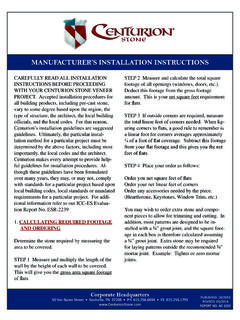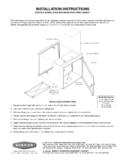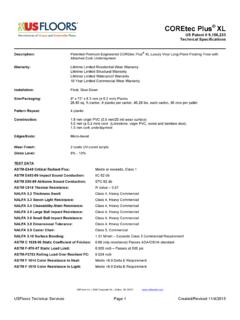Transcription of OWNER’S GUIDE & INSTALLATION INSTRUCTIONS
1 17-335-01-irev. 1106/01/15 External-Mount, 2-3kWDepth Transducer with Temperature SensorModels: R99, R109LH, R109LM, R109 LHW, R209, R309, R409 LWM, R509LH, R509LM, Patent No. 7,369,45; 8,582,393. UK Patent No. 2 414 077 IMPORTANT: Please read the INSTRUCTIONS completely before proceeding with the INSTALLATION . These INSTRUCTIONS supersede any other INSTRUCTIONS in your instrument manual if they Recommended for all hull materials Not recommended for hulls less than 9 m (30') long Not recommended for stepped hulls. Mount an in-hull transducer Accommodates a deadrise angle up to 22 Unpacking & PretestRemove and discard the packing hardware (rod and 2 nuts) (see Figure 1). Connect the temperature function to the instrument and check for the approximate air temperature. If there is no reading or it is inaccurate, check the connections and test again. If there is still a problem, return the product to your place of & MaterialsSafety gogglesDust maskAngle finderBand saw (blade must be very sharp)Rasp or power toolElectric drillDrill bits:pilot hole3 mm or 1/8"fiberglass, wood, or steel hull14 mm or 9/16"aluminum hull15 mm or 9/16"Permanent markerMild household detergent or weak solvent (such as alcohol)SandpaperFile ( INSTALLATION in a metal hull)Marine sealant (suitable for below waterline)WrenchesTorque wrenchGrommet(s) (some installations)Cable tiesWater-based anti-fouling paint (mandatory in salt water)Record the information found on the cable tag for future No.
2 :_____Date_____Frequency_____kHztransduc erfairingRemoveand discardthe 1. Packing hardwareCopyright 2007 Airmar Technology the precautions below for optimal product performance and to reduce the risk of property damage, personal injury, and/or : Boats capable of speeds above 25 kn (29 MPH) You must follow these INSTRUCTIONS for a safe INSTALLATION . For boats exceeding 35 kn. (40 MPH) or when the INSTRUCTIONS cannot be met, mount an in-hull transducer. At high speeds, the fairing and/or transducer may break away from the : A stuffing tube is required. The stuffing tube seals the hull forming a water-tight conduit for the : Always wear safety goggles and a dust mask when : The fairing must be installed parallel to the keel to ensure proper boat handling and water flow under the : Immediately check for leaks when the boat is placed in the water. Do not leave the boat in the water unchecked for more than three hours. Even a small leak may allow considerable water to : Fiberglass hull The transducer and stuffing tube must be installed in solid fiberglass, not in coringCAUTION: Aluminum hull The stainless steel hardware must be isolated from an aluminum hull to prevent electrolytic : Steel hull Follow generally accepted INSTALLATION : Never install a metal fitting on a vessel with a positive ground : External mount only.
3 The transducer will overheat if it is mounted in a hull : Never pull, carry, or hold the transducer by its cable. This may sever internal : Never strike the : Tighten the nylon locking nuts with a torque wrench using a force not exceeding 27 N-m ( ). Do not over tighten. It may crack the transducer and / or crush the : Never use solvents. Cleaner, fuel, sealant, paint, and other products may contain solvents that can damage plastic parts, especially the transducer s INSTRUCTIONSOWNER S GUIDE &2 Figure 6. FairingFigure 5. Fairing NOTE: After the fairing is cut,the section with the cutting GUIDE becomes the backing (3/4")cuttingguidecavity for22 viewaft viewCopyright 2007 - 2011 Airmar Technology 2005 Airmar Technology 4. Cutting the fairingcuttingguideband sawtabledeadriseanglefenceCopyright 2005 Airmar Technology stuffingtubeBow>Mounting LocationGuidelinesCAUTION: Do not mount in line with or near water intake or discharge openings or behind strakes, fittings, or hull irregularities that will disturb the water : Do not mount the sensor where the boat may be supported during trailering, launching, hauling, or storage to avoid damaging the transducer s face.
4 The water flowing under the hull must be smooth with a minimum of bubbles and turbulence (especially at high speeds). The transducer must be continuously immersed in water. The transducer beam must be unobstructed by the keel or propeller shaft(s). Choose a location away from interference caused by power and radiation sources such as: the propeller(s) and shaft(s), other machinery, other echosounders, and other cables. The lower the noise level, the higher the echosounder gain setting that can be used. Choose a location with a minimal deadrise angle, not to exceed 22 . Choose an accessible spot inside the vessel with adequate space for the height of the stuffing tube and tightening the Types Displacement hull powerboat Locate about 1/3 of the way along the LWL and 200 600mm (8 24") off the centerline (see Figure 2). The starboard side of the hull where the propeller blades are moving downward is preferred. Planing hull powerboat (see Figure 3) Mount within the aft 1/3 of the hull, as far back as possible.
5 Outboard and I/O Mount just forward of the engine(s). Inboard Mount ahead of the propeller(s) and shaft(s). Mount on or as close to the centerline as possible, and well inboard of the first set of lifting strakes to ensure that the transducer is in contact with the water at high speeds. Mounting on the starboard side of the hull where the propeller blades are moving downward is TubeAfter determining the best mounting location for the transducer, install the stuffing tube. Follow the INSTALLATION INSTRUCTIONS packaged with the stuffing : Cutting, Bedding & InstallingCutting the FairingCAUTION: Shape the fairing to the hull as precisely as possible. If there are gaps between the fairing and the hull near the ends, cut a new fairing. Over tightening the rods to minimize gaps may crack the transducer and / or crush the Measure the deadrise angle of the hull at the stuffing tube using an angle finder or digital level (see Figure 2).2. Tilt the band saw table to the measured angle and secure the cutting fence (see Figure 4).
6 Do not exceed 22 .3. Place the fairing on the table so the cutting GUIDE rests against the fence (see Figures 4 and 5). Note the fairing is Adjust the fence so the fairing will be cut in about two equal parts. The section that will become the fairing must be a minimum of 20mm (3/4") at its thinnest dimension (see Figure 6).5. Recheck steps 1 through 4; then cut the Check the fit by placing the fairing against the hull. Be sure the fairing is parallel to the centerline of the boat (keel), and the stuffing tube is about 2/3 of the way back in the cavity (see Figure 5). Hold the fairing on the ends and try to rock it back and forth. Shape the fairing to the hull as precisely as possible with a rasp or power tool until it no longer of hullparallel to Figure 2. Transducer location on displacement hullpressure waves1/3(8 24")200-600mmLWL(Load Waterline Length)anglewaterlineCopyright 2005 Airmar Technology 3. Transducer location on planing hullinboardoutboard and I/OCopyright 2005, 2009 Airmar Technology : Mount within theaft 1/3 of the hull, as farback as 8.
7 Threaded rod102 mmcolor this section ofrod withpermanentmarker(4")Copyright 2007 - 2015 Airmar Technology forinstallationin aluminumhull only3 Figure 7. Bedding and installing the fairing and backing block (non-metal hull shown)fairingbackingthreadedhullmarinese alant onmarinesealant onwashers (2),backing block,fairing,recessrod (2)block(uncolored)Copyright 2007 Airmar Technology (2-3/4")metal nut& washerABow >threadedmetal nut (4)nylon locking nut (2)marine sealant onwasher (2)and washer (2)metal nut (2)transducerhullfoam plug (2)Bow >Figure 9. Bedding and installing the transducer (non-metal hull shown) backing blockwasher (2)stuffingcablefairingrounded bottomtemperaturetubesensorrod (2)transducer that contactsfairing and recessCopyright 2007 Airmar Technology sealantflush with hullrods (2)7. The remaining section of the fairing with the cutting GUIDE will be used as the backing block inside the hull. It will provide a level surface for tightening the nuts on the threaded Fitting the Fairing1.
8 To locate the hole for the forward threaded rod (nearest the bow), measure the distance between the cable exit and the forward hole in the transducer, center to center. (The rounded bottom is forward and the temperature sensor is aft.) Being sure the fairing will be parallel to the centerline of the boat (keel), measure this distance A on hull and mark the hole (see Figure 7).2. Drill a pilot hole at the marked location. Using the appropriate size drill bit, drill the hole through the hull for one threaded rod. Do not drill the second hole at this Prepare the threaded rods (see Figure 8). Using a permanent marker, draw a line on each threaded rod 102mm (4") from the end and color this section. (The colored section will be used to fasten the transducer to the fairing.) Screw a nut onto the colored section of each threaded rod above the 102mm (4") line drawn. 4. Place the fairing against the hull. Push the uncolored end of the threaded rod through the fairing and the hull until the nut rests inside the recess in the fairing (see Figure 7).
9 With a person stationed inside the vessel, slide the backing block onto the rod. Temporarily secure the rod with a stainless steel washer and the fairing parallel to the centerline of the boat (keel). Using the aft hole in the fairing as a GUIDE , drill a pilot hole. Then drill the hole using the appropriate size drill Remove the fairing from the hull. Clean and sand the area around the holes, inside and outside, to ensure that the marine sealant will adhere properly. Remove any petroleum residue with a mild household detergent or a weak solvent such as hull Remove all burrs with a file and & Installing the FairingCAUTION: Be sure the surfaces to be bedded are clean and If there is any residue on the fairing and transducer, remove it with a mild household detergent to ensure the marine sealant will adhere Apply a 2mm (1/16") thick layer of marine sealant: (see Figure 7) To the surface of the backing block that will contact the hull To the surface of the fairing that will contact the hull To the recesses in the fairing for the washers and nuts To the threaded rods To the surface of the washers that will contact the backing blockNOTE: Be sure the rods have marine sealant on the threads under the nuts.
10 Back each nut off 13mm (1/2") and apply sealant to the threads. Then return each nut to the marked location on the Slide a washer along the uncolored section of each threaded rod until it rests against the nut (see Figure 8).Aluminum hull The stainless steel rods must be isolated from an aluminum hull to prevent electrolytic corrosion. Cut the isolation sleeve 70 mm (2-3/4") long. Slide the isolation sleeve over the uncolored section of each bedded rod as far down as possible. Apply a 2 mm (1/16") thick layer of the marine sealant to the outside of the 2005 - 2015 Airmar Technology Corp. All rights reserved. 4. Push the uncolored section of each threaded rod through the fairing, the hull, and the backing block until the washer rests inside the recess in the fairing (see Figure 7). With a person stationed inside the vessel, secure each rod with a washer (bedded side against the backing block) and double stainless steel nuts. Use a wrench to hold the lower nut while tightening the top nut against hull The top of the isolation sleeve must be below the top of the backing block to prevent the sleeving from interfering with tightening the hull Allow the wood to swell before tightening the : Bedding & Installing1.







